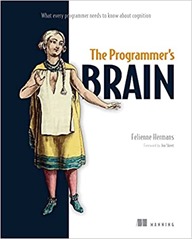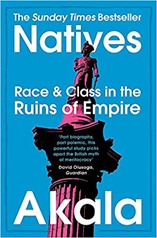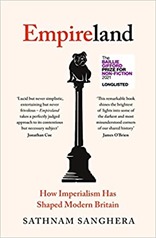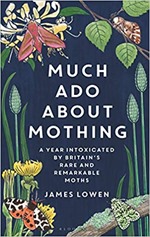 I picked up The Programmer’s Brain by Felienne Hermans, as a result of a thread on Twitter. I’ve been following Hermans for quite a while, and knew the areas of computer science she worked in but my interest in Programmer’s Brain was stimulated by a lengthy thread she posted over the Christmas break.
I picked up The Programmer’s Brain by Felienne Hermans, as a result of a thread on Twitter. I’ve been following Hermans for quite a while, and knew the areas of computer science she worked in but my interest in Programmer’s Brain was stimulated by a lengthy thread she posted over the Christmas break.
The book is based around the idea of the brain as having long term (LTM), short term (STM) and working memory and how these different sorts of memory come into play in programming tasks, how we can improve our memories, and how we can write code that supports our use of them. It cites a fair number academic studies in each area it looks at.
The book is divided into four parts.
The first part covers the reading of code. We do a lot of training on how to write code but none on reading it, yet as developers we spend a lot of time reading code, either our own code from the past, the code of our colleagues or library code.
Perhaps most traumatic for me was the suggestion that I should learn syntax. Hermans suggests flash cards to learn syntax, as an aid to reading code (and writing it), highlighting that going and looking up syntax is likely to break our flow, by the time we have checked out twitter and some pictures of kittens. Thinking about my own behaviour, this is definitely true. My first flash cards would all be around Python – set syntax, format statements, unittests boilerplate and the options for sort and sorted.
An idea I hadn’t come across before was refactoring code for readability which may be at odds with how code currently stands; you might, for example, inline functions to remove the need to go look them up and potentially lose your place in code. Or replace lambdas, list comprehensions or ternary operators – all of which take a bit more effort to parse – with their more verbose, conventional alternatives.
Two things that aid reading code are “chunking”, experts in a field, like chess or programming, don’t learn remember every detail but they know the rules of possibility so they can break up a programme or a chess position into larger pieces (or chunks). They thus have better recall than novices.
The second aid to reading code are beacons, variable names and comments that hint about the higher purpose of code, to enable you to recall the right chunks. That’s to say if you are implementing code that uses a binary try you use the conventional names of root, branch, node, left and right rather than trying to be individualistic.
I suspect a lot of programmers, like me, will be looking at the rote learning exercises that Hermans proposes and starts to think immediately about how to automate them! I think there is scope for IDE extensions that allow you set up some flashcards or little code exercises. Also Hermans proposes quite a lot of printing out code and annotating it, again this was something I’d quite like IDE support for.
The second part is on understanding code more deeply, how it works. I was interested to learn that our natural language abilities are a better predictor of how good we are at comprehending what code does, than our mathematical abilities. In terms of understanding code, Hermans talks about marking up listings of code to highlight the occurrence of functions and variables. And, furthermore, to label variables by role following the work of Sajaniemi that is to say into the categories of fixed value, stepper, flag, walker (like a stepper), most recent holder, most wanted holder, gatherer, container, follower, organiser, and temporary. The co-occurrence of these roles provides strong clues as to what code does – in the same manner as design patterns. If we spot a design pattern we can access our long term memory as to what a design pattern does.
Following on from the idea of labelling roles of variables is the somewhat depreciated “Hungarian notation” proposed by Simonyi. This is where you include some type or role information in a variable name such as “strMyName” or “lb_textbox”, Simonyi’s original proposal was to name variables with their roles, rather than just their types which is rather less useful in strongly typed languages and modern IDEs with syntax highlighting.
The third part is on writing code, starting with the importance of naming things. The key here is consistency in naming (i.e. stick with either snake case or camel case, don’t mix), and agreeing a “name mould” – a pattern for compiling parts of a name. Martin Fowler’s “code smells” are also covered in this section, highlighting how they interact with the model and how bad code smells prevent us accessing our long term memories.
The final part is on collaborating on code, including the developer’s great bugbear “the interruption”, it turns out this annoyance is well-founded with research showing that an interruption typically requires 15-20 minutes for recovery. I was also interested to see that we are not very good at multi-tasking, although we might think we are.
Also in this part is a discussion of the cognitive dimensions of code bases (CDCB), these are ideas like the error proneness of code, how easy it is to modify, how easy it is to test in parts applied at the level of an application or library. There is an implication here that the language you use to build a library may change over the course of time, perhaps starting with Python when you are roughing things out quickly, adding in type hinting when the library is more mature and shifting to Scala or Java when the design is stable and better performance is needed.
Finally, there is a small piece on onboarding new developers to a project, here the ideas of cognitive load repeat. Often when we are onboarding a new developer we show them the code, introduce a load of people, draw diagrams and so forth – all very fast. Under these circumstances our ideas about cognitive load tell us anyone will be overwhelmed.
I enjoyed this book, it feels like a guide to getting better at doing something I spend a lot of my time on. It is an area, learning in the field of programming, that I have not seen written about elsewhere.
Hopefully this book will change the way I work a bit, I’ll try to learn more syntax, I’ll not worry about reusing the same variable names, or even using Hungarian notation. I’ll try to remember the roles of variables. And I’ll try Hedy out with my son, Hedy is the teaching language Hermans wrote while also writing this book.


 Index, A History of the
Index, A History of the
